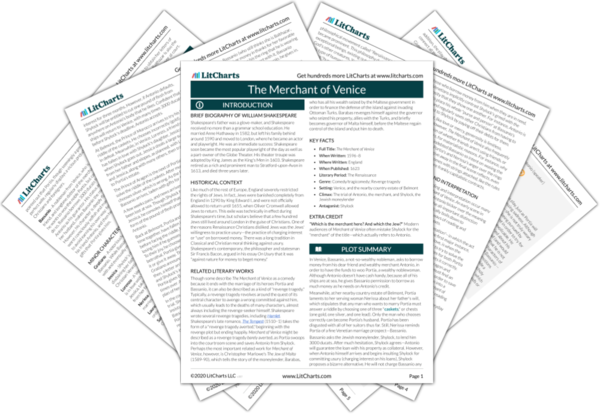In connection with mercy and generosity, The Merchant of Venice also explores love and friendship between its characters. The central romantic relationship of the play is that between Bassanio and Portia. Their marriage is paralleled by several others: the elopement of Shylock's daughter, Jessica, with the Christian, Lorenzo; and the marriage of Portia's servant, Nerissa, to Bassanio's companion, Gratiano. In addition, numerous critics have suggested that the strongest friendship in the play—between Antonio and Bassanio—also approaches romantic love. In addition, the play shows how strong the amicable ties are that connect all the various Venetian characters.
Given the generosity that they motivate between characters, love and friendship might seem to offer alternatives to the ugly emotions of prejudice, greed, and revenge on display in The Merchant of Venice. However, beginning with Bassanio's borrowing money from his friend Antonio in order to woo Portia, the play also demonstrates that the apparent purity of love and friendship can be tainted by selfish economic concerns. In addition, love and friendship are also at the mercy of the law, as seen in Portia's being subject to the terms of her father's riddle of the caskets.
Love and Friendship ThemeTracker

Love and Friendship Quotes in The Merchant of Venice
A stage, where every man must play a part;
And mine a sad one.
I shot his fellow of the selfsame flight
The selfsame way, with more advised watch,
To find the other forth; and by adventuring both,
I oft found both.
Are with more spirit chased than enjoy'd.
The pretty follies that themselves commit.
Or in the heart or in the head?
How begot, how nourished?
Reply, reply.
It is engender'd in the eyes,
With gazing fed; and fancy dies
In the cradle, where it lies.
Let us all ring fancy's knell;
I'll begin it – Ding, dong, bell.
Nor is not moved with concord of sweet sounds,
Is fit for treasons, stratagems, and spoils;
The motions of his spirit are dull as night,
And his affections dark as Erebus.
Let no such man be trusted.
















